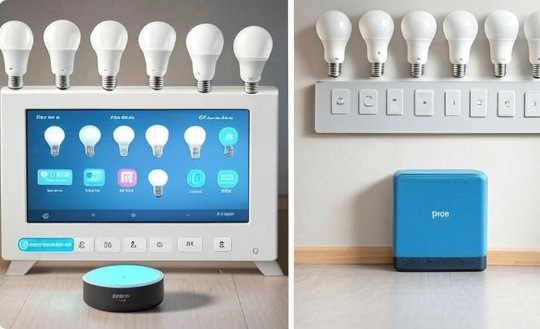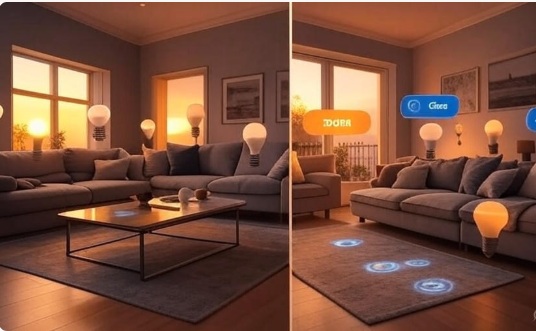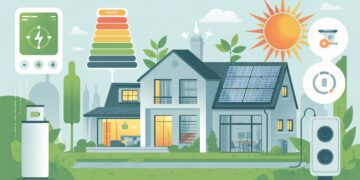Lighting is an essential part of our daily lives, shaping our environment, enhancing safety, and influencing mood and productivity. Over the years, lighting technology has evolved tremendously—from incandescent bulbs to energy-saving LEDs, and more recently to smart lighting systems that connect to your smartphone or voice assistant.
Choosing the right lighting for your home or office is no longer a simple matter of picking a bulb that fits a socket. The decision now involves understanding the differences, benefits, and drawbacks between smart lighting and traditional bulbs. In this comprehensive guide, we dive deep into Smart Lighting vs Traditional Bulbs – Pros & Cons, so you can make a confident, informed choice.
Table of Contents
ToggleIntroduction to Lighting Technologies
Before comparing smart lighting and traditional bulbs, it’s important to understand what each category entails.
What Are Traditional Bulbs?
Traditional bulbs are conventional light sources that have been used for more than a century. These include:
-
Incandescent bulbs: The earliest form of electric light bulbs, incandescent bulbs produce light by heating a filament until it glows. Although widely used for decades, these bulbs are known for being energy inefficient.
-
Halogen bulbs: A type of incandescent bulb that contains halogen gas to increase efficiency and lifespan.
-
Compact Fluorescent Lamps (CFLs): These use a fluorescent coating and mercury vapor to produce light. CFLs are more energy-efficient than incandescent bulbs but have been largely replaced by LEDs.
-
Standard LED bulbs: While LEDs are modern and efficient, many still consider standard LEDs as “traditional” because they lack connectivity or “smart” features.
What Is Smart Lighting?
Smart lighting refers to lighting systems that can be controlled digitally—via smartphone apps, voice assistants, or automation systems. Smart bulbs are typically LED-based and come equipped with wireless technologies like Wi-Fi, Bluetooth, or Zigbee.
Smart lighting offers a range of features such as remote control, scheduling, color-changing capabilities, integration with smart home ecosystems, and energy monitoring.
Smart Lighting vs Traditional Bulbs – Pros & Cons: Detailed Comparison
Let’s explore the key aspects where smart lighting and traditional bulbs differ, starting with the advantages and disadvantages of each.
Traditional Bulbs: Advantages and Disadvantages
Pros of Traditional Bulbs
-
Low Initial Cost
Traditional bulbs, especially incandescent and halogen types, are inexpensive and widely available. This makes them attractive for people on a budget or those needing quick, affordable lighting. -
Simple Installation
They fit into virtually all standard sockets without additional setup, adapters, or special equipment. -
Immediate Full Brightness
Unlike some energy-saving bulbs like CFLs, traditional bulbs reach full brightness instantly when switched on. -
Warm Light Quality
Many people prefer the warm, natural light emitted by incandescent bulbs, which is often considered more flattering and comfortable. -
No Technical Learning Curve
Traditional bulbs do not require any apps, networks, or compatibility checks—just screw them in and use.
Cons of Traditional Bulbs
-
High Energy Consumption
Incandescent bulbs convert less than 10% of electricity into visible light; the rest is lost as heat. This inefficiency leads to higher electricity bills. -
Short Lifespan
Most incandescent bulbs last about 1,000 hours, much shorter than LEDs or smart bulbs. Frequent replacements can be costly and inconvenient. -
Environmental Concerns
Their inefficient energy use contributes to a larger carbon footprint and more waste due to short lifespans. -
Limited Functionality
Traditional bulbs offer no customization or automation features—control is limited to on/off via wall switches. -
Heat Emission
Incandescent and halogen bulbs generate significant heat, which can be a safety concern and increase cooling costs.
Smart Lighting: Advantages and Disadvantages
Pros of Smart Lighting
-
Energy Efficiency
Smart bulbs utilize LED technology combined with intelligent control to significantly reduce power consumption—often using 75-80% less energy than incandescent bulbs. -
Extended Lifespan
Smart LEDs typically last between 15,000 to 25,000 hours, reducing the frequency and cost of replacements. -
Remote and Automated Control
You can control smart lights from your smartphone or through voice commands with devices like Amazon Alexa, Google Assistant, or Apple Siri. Schedule lights to turn on/off automatically, enhancing convenience and energy savings. -
Color and Brightness Customization
Adjust brightness levels and choose from millions of colors to create the perfect ambiance for any occasion or mood. -
Integration with Smart Home Systems
Smart lighting can sync with other smart devices like thermostats, security cameras, and motion sensors to provide a cohesive and intelligent home environment. -
Security Enhancements
Automated lighting schedules or motion-activated lights can deter intruders by simulating occupancy when you’re away. -
Energy Monitoring and Insights
Some smart lighting systems provide data on energy use, helping you optimize consumption and reduce bills.
Cons of Smart Lighting
-
Higher Upfront Cost
Smart bulbs and compatible switches cost significantly more than traditional bulbs, which can deter budget-conscious buyers. -
Technical Complexity and Setup
Installation requires a Wi-Fi network, compatible fixtures, and some technical knowledge. Initial setup can be confusing for non-tech-savvy users. -
Compatibility Issues
Not all smart bulbs fit every fixture, and some may not integrate seamlessly with every smart home platform. -
Dependence on Internet Connectivity
Many smart lighting features rely on stable internet access; without it, some functions may be limited. -
Privacy and Security Risks
As with all connected devices, smart lighting systems can be vulnerable to hacking or unauthorized access if not properly secured.
Smart Lighting vs Traditional Bulbs – Key Factors to Consider
1. Cost: Initial and Over Time
-
Traditional Bulbs:
Very low purchase price but higher electricity consumption and frequent replacements increase total cost of ownership over time. -
Smart Lighting:
High upfront cost due to bulb price and possible additional hardware (smart hubs, switches). However, energy savings and fewer replacements make them more cost-effective long term.
2. Energy Efficiency and Environmental Impact
-
Smart lighting LEDs are far superior in efficiency, consuming a fraction of the power that incandescent or halogen bulbs use.
-
Lower energy consumption translates to reduced carbon footprint and less environmental strain.
-
Smart features allow lights to be turned off automatically when not needed, further reducing waste.
3. Lifespan and Maintenance
-
Incandescent bulbs last about 1,000 hours; halogen bulbs up to 2,000 hours.
-
CFLs last longer (~8,000 hours), but smart LED bulbs lead the pack with 15,000 to 25,000+ hours.
-
Reduced bulb replacements mean less hassle and waste.
4. Functionality and Control
-
Traditional bulbs offer simple on/off control.
-
Smart bulbs offer remote operation, scheduling, dimming, color changing, voice commands, and automation.
5. Aesthetic and Ambiance
-
Traditional bulbs provide warm, familiar lighting.
-
Smart bulbs provide an expansive range of colors and brightness levels to create various moods.
6. Installation and Compatibility
-
Traditional bulbs: Plug and play.
-
Smart bulbs may require compatible sockets, hubs, and reliable Wi-Fi networks.
7. Security Features
-
Smart lighting can simulate presence and integrate with security systems.
-
Traditional lighting offers no such options.
Practical Use Cases: Where Each Lighting Type Excels
Traditional Bulbs: Best For
-
Spaces where lighting is rarely used or cost is the main concern.
-
Fixtures that cannot accommodate smart bulbs.
-
Simple environments such as garages, closets, and storage rooms.
-
Temporary lighting solutions.
Smart Lighting: Best For
-
Living rooms, bedrooms, and kitchens where ambiance and mood lighting matter.
-
Home offices needing adaptable brightness and color temperature.
-
Outdoor lighting for security and convenience.
-
Smart home enthusiasts seeking automation and integration.
-
Energy-conscious households aiming to reduce consumption.
How to Transition from Traditional to Smart Lighting
Switching from traditional bulbs to smart lighting doesn’t need to be overwhelming. Here’s a step-by-step approach:
-
Assess Your Needs
Identify rooms where you want smart features: living room, kitchen, bedroom. -
Check Compatibility
Verify bulb socket sizes and Wi-Fi coverage. -
Start Small
Buy a few smart bulbs or smart switches and test them out. -
Set Up a Hub or App
Install and configure the companion app or smart home hub. -
Experiment with Features
Try scheduling, voice control, and color settings. -
Expand Gradually
Add smart lighting to other rooms once comfortable.
Frequently Asked Questions (FAQs)
Q1: Are smart bulbs compatible with dimmer switches?
Some smart bulbs have built-in dimming capabilities and should not be used with traditional dimmer switches, as this can cause flickering. Always check manufacturer recommendations.
Q2: Can I use smart bulbs without a smartphone?
Basic on/off and brightness can usually be controlled via physical switches, but advanced features require a smartphone or voice assistant.
Q3: How much can smart lighting reduce my energy bill?
Energy savings depend on usage patterns, but many users see reductions of 20-50% compared to incandescent bulbs.
Q4: Are there privacy concerns with smart lighting?
Yes, smart lighting devices connected to your network can be vulnerable. Use strong passwords and secure your Wi-Fi to minimize risks.
Q5: What happens if my internet goes out?
Some smart bulbs retain basic on/off functionality locally, but remote control and automation features may be unavailable.
Conclusion: Making the Right Choice for Your Home
Deciding between Smart Lighting vs Traditional Bulbs – Pros & Cons requires weighing budget, convenience, environmental impact, and functionality.
-
Traditional bulbs are suitable if you want low upfront cost and simple, reliable lighting without bells and whistles.
-
Smart lighting is ideal if you prioritize energy efficiency, long-term savings, convenience, customization, and integration with smart home devices.
For most modern households, smart lighting represents the future of illumination, offering unprecedented control, flexibility, and efficiency. However, traditional bulbs still have a place where simplicity and cost matter most.
Take the time to consider your specific needs and preferences, and you’ll be well on your way to creating the perfect lighting environment that suits your lifestyle.












